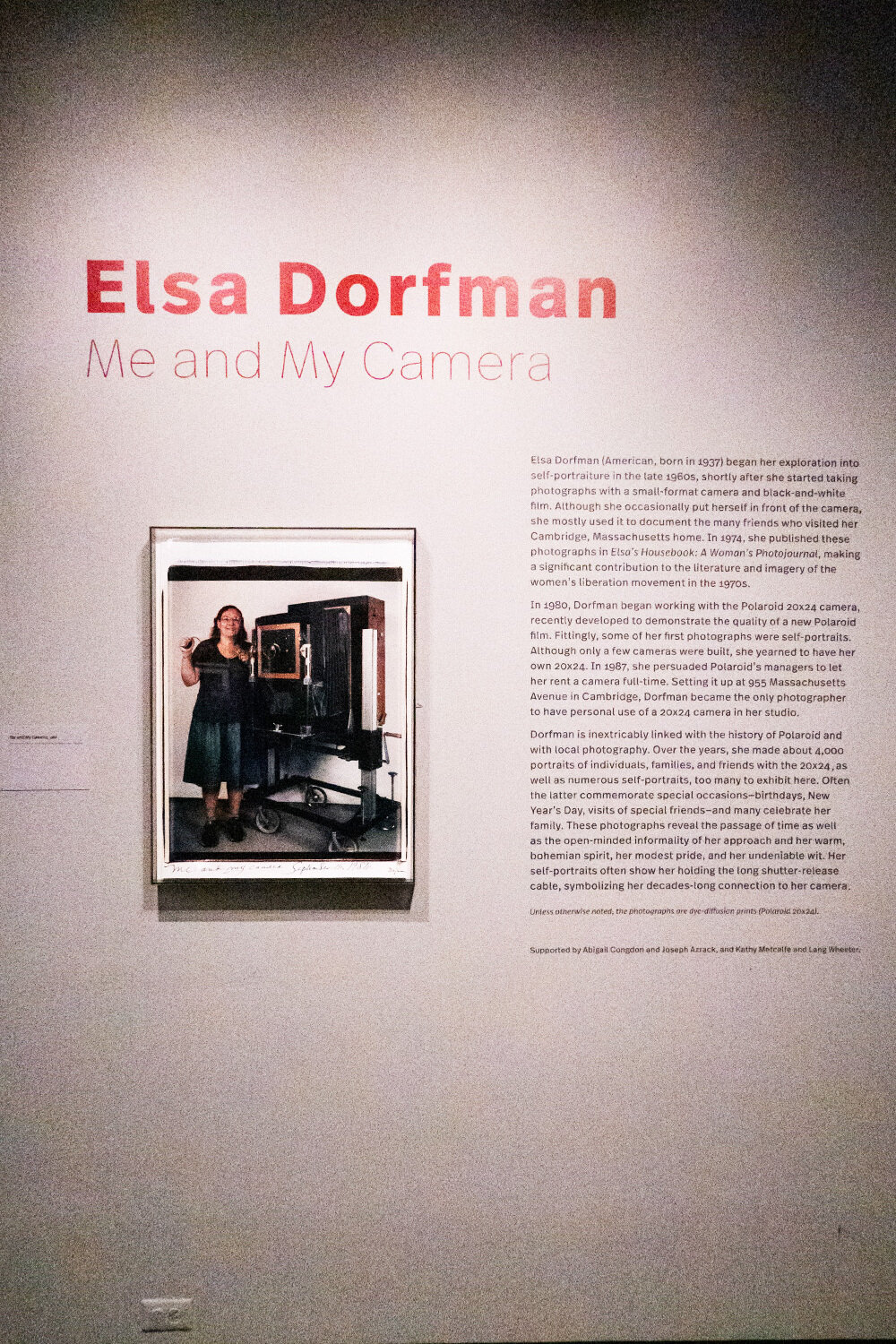On March 11th, 2020 my son and I stopped by the Museum of Fine Arts in Boston, which is one of my favorite museums. Even though at the time I knew COVID cases had reached the United States and things were changing, I didn’t think this would be the last exhibition space I would see up until now and till who knows when. The following day all Boston area museums closed.
The Herb Ritts Gallery, the MFA’s primary photography gallery room, was showing Elsa Dorfman’s 20” x 24” Polaroid Prints in an exhibition titled “Me and My Camera”. It was scheduled from February 8th through June 21st, 2020. Dorfman was an American photographer born in 1937 who lived in Cambridge, Massachusetts. Her first notable work was her 1970 book: Elsa’s Housebook: A Woman’s Photojournal, which was seen as prominent within the women’s liberation movement of the 1970’s. Her notable work is her portraiture and this exhibition featured her images made with the very rare Polaroid 20” x 24” view camera, of which only five cameras were made. Dorfman began using this camera in 1980 and in 1987 she was granted a full-time rental of the camera. She was the only individual to have full time use of one. Over her career she made over 4,000 portraits with this camera.
The MFA described Elsa as having a “Bohemian Spirit” and I think that spirit really shows in her self portraits.
There are a couple things I really came to appreciate about this exhibition. Walking in the MFA door that day I did not know anything about Elsa or her work. But when I left that day, I had an appreciation for who Else was and how passionate she was about photography. We all know that we now live in the “Selfie” culture, where millions of self portraits are posted and shared daily on social media. It is how so many of us just say hello to each other. I do not want to deviate into a long discussion about self-portraits, but what I want to mention is the difference between Elsa’s portraits and the “Selfie” of today. The most obvious thing is the process. To create a 20” x 24” Polaroid print takes time, effort, and expense. But as simple as Elsa’s portraits seem they really are crafted in a way which really seem to reveal herself to the viewer. I think she portrays herself exactly as she truly is, and does so being very comfortable in herself. The MFA describes the exhibition of Elsa’s work perfectly with this statement: “Like all of Dorfman’s work, the photographs in this exhibition radiate warmth, inviting visitors into the intimate moments of an extraordinary life.” While looking for links to included in this blog post I discovered that Elsa passed away from kidney failure on May 30th, 2020, while her prints still hung on the walls of the MFA. The New York Times obituary had a fantastic quote by Elsa about the subjects she photographed: “I do not try to probe or illuminate their souls.” “They embrace their uneven features and the cowlick that won’t stay down — even the few extra pounds. The Japanese have a word for this pose of total naturalness and total attention — ‘sonomama.’” The Times also had another great quote from Elsa: “The camera is like a fork or a spoon. It’s an instrument you eat your soup with. It’s not the soup.” I just love the insight.
The other thing I came away with was better understanding of the 20” x 24” Polaroid view camera. I was very aware of William Wegman’s images and his use of the Polaroid view camera while I was studying at Arizona State University in the mid 1980’s. I think I even saw one of these cameras in person before. It was during my 1988 trip to New York to see the Winogrand retrospective at MoMA and went all over the city. It was an epic trip, I exposed at least a couple dozen rolls in my Leica walking around the street and I checked out a bunch of galleries. I think it was somewhere near 568 Broadway, there were a few galleries in that area, where I wandered into a space with all these Wegman Polaroid prints of Fay Ray on the walls. At first, I thought it was a gallery then I figured out it was a studio. No one was around so I explored it for a few minutes and I think I saw a 20” x 24” Polaroid camera in there, that was 32 years ago so my facts could be off but I definitely remember concluding at the time it was Wegman’s studio (I have tried some on line searches today to confirm the location, just for my own curiosity, but haven’t had any success). Finally, a woman came out from a back room and asked why I was there. She was super nice, and politely explained it was a private studio. Their fault for leaving the door open, but I thanked her and left while taking another quick glance around the space. Funny thing was someone also left the roof access door open in that building too, and the roof was actually had some nice vistas of SOHO.
I spent some time today researching the 20” x 24” Polaroid view camera today and here are the links to those sites:
Plus since I brought him up, here are some Wegman sites (always healthy to enjoy his images, especially in the stress of today’s world):
https://www.speronewestwater.com/artists/william-wegman
https://www.smithsonianmag.com/arts-culture/fay-ray-the-supermodel-dog-48273759/
Links for Elsa Dorfman:
https://www.harvardmagazine.com/2017/09/elsa-dorfmans-portrait-photography
The MFA also was showing the work of Iranian born photographers Gohar Dashti and Bahman Jalali. The images were beautifully crafted and again I enjoyed seeing work which I had not seen before.
Gohar Dashti - Iranian Born 1980 - “Home 2017” Ink Jet Print
I am missing lots of things in today’s world, writing this post today reminded me of that fact once again. Mask up, be smart, and hopefully we can start doing more of the things we enjoy sooner rather than later.
Museum of Fine Arts - Boston, Massachusetts - March 11th, 2020








